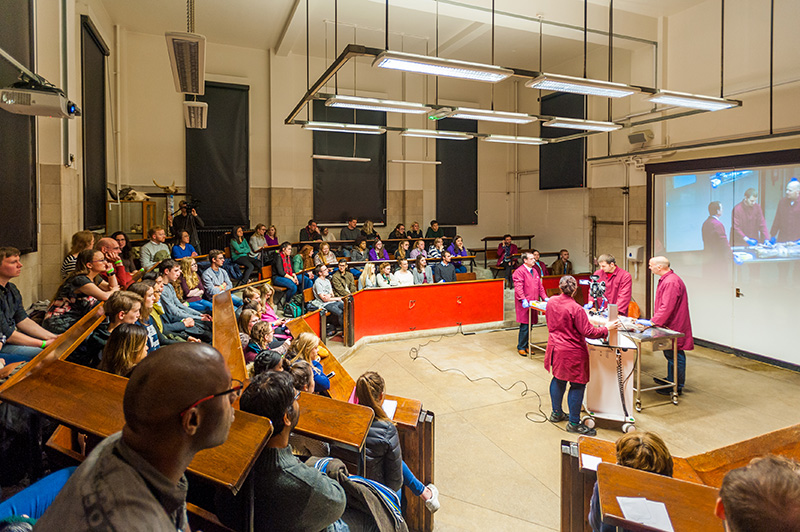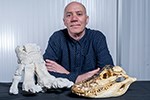Wild Cats Uncovered
Zoologists, vets, biologists, and students joined researchers from University College London (UCL) and the °ÄĂĹÁůşĎ˛ĘąćÂÉÂŰĚł (RVC) in a one-off event giving a unique insight into the evolution of cat anatomy and movement.
During the event, entitled Wild Cats Uncovered: movement evolves, which took place at the RVC’s Camden campus on 10 November, leading experts in feline anatomy performed a post mortem on a cheetah before a live audience.
Informally known as ‘Team Cat’ and headed by Professors Anjali Goswami from University College London and John Hutchinson from the °ÄĂĹÁůşĎ˛ĘąćÂÉÂŰĚł, researchers have brought together their expertise in evolution and biomechanics to better understand the evolution of form and movement within the cat family. For most animal groups, as they get bigger their posture changes: their legs tend to straighten and become stiffer to support their weight. But not cats. Despite ranging in size from 1kg to over 300kg, living members of the cat family are strikingly similar in their posture and how they stand or move. For scientists from Team Cat, the idea of the ‘crouching tiger’ is an evolutionary mystery they set out to investigate over the course of the project.
The post-mortem on the cheetah, which had died of natural causes, revealed insights about the individual animal, and the cat family. In terms of the individual cheetah’s pathology, abnormalities in the gallbladder, spleen, liver and lungs and overall weight were consistent with the cheetah having died of a disease such as cancer.

Regarding the post mortem, Professor Hutchinson said: “We shared a unique opportunity to celebrate the amazing form, function and evolution of cats in general, and the spectacular beauty of the cheetah specimen’s anatomy as well as its life and some clues about the sad story of its demise. We were flooded with challenging, insightful questions from the very enthusiastic audience and it was a joy to hear how much people attending appreciated the event. It was a very important event for us, considering our commitment to engaging the public with scientific research.”
In terms of the cat family, Team Cat has used a variety of techniques over the last three years to understand their anatomy; from tempting tigers to cross 3D scales that measures the force produced as they walk, to dissections of wild cats that died of natural causes in zoos and parks, to even CT scanning and measuring the remains of fossil cats to capture their shape in 3D. Using these techniques, the scientists involved have been piecing together the developmental, ecological and biomechanical influences that have shaped the evolution of the cat musculoskeletal system.
Professor Goswami said: “In evolutionary biology, we spend a lot of time trying to identify grand unifying processes or patterns that are repeated across different groups or different periods in Earth history, but the exceptions to these rules can sometimes tell us even more about how the current diversity of life evolved and why organisms look and behave the way they do. It shouldn’t come as any surprise to a cat lover that cats are one of the weird groups that break the rules, and we are looking at this from numerous angles, from development to biomechanics, and using a wide range of analytical techniques to understand how they get away with it.”
Professor Hutchinson said: “We brought together a dream team of researchers with expertise across the fields of anatomy, development, mechanics, evolution and palaeontology to tackle big questions about big and small cats. It has been an exciting three-year study that is putting together some big puzzle pieces about the evolution of cats and their form, function and behaviour. This event showed and celebrates our latest findings.”
The “Walking the Cat Back” project is funded by the Leverhulme Trust.
Press Office Contact
Uche Graves / Zoe White
T: 0800 368 9520
E: uche.graves@plmr.co.uk / zoe.white@plmr.co.uk
Notes to Editors
The °ÄĂĹÁůşĎ˛ĘąćÂÉÂŰĚł (RVC) is the UK's largest and longest established independent veterinary school and is a constituent College of the University of London. The RVC offers undergraduate, postgraduate and CPD programmes in veterinary medicine, veterinary nursing and biological sciences, being ranked in the top 10 universities nationally for biosciences degrees. It is currently the only veterinary school in the world to hold full accreditation from AVMA, EAEVE, RCVS and AVBC.
A research-led institution, in the most recent Research Excellence Framework (REF2014) the RVC maintained its position as the top HEFCE funded veterinary focused research institution.
The RVC also provides animal owners and the veterinary profession with access to expert veterinary care and advice through its teaching hospitals; the Beaumont Sainsbury Animal Hospital in central London, the Queen Mother Hospital for Animals (Europe's largest small animal referral centre), the Equine Referral Hospital, and the Farm Animal Clinical Centre located at the Hertfordshire campus.
University College London (UCL) was founded in 1826 and was the first English university established after Oxford and Cambridge, the first to open up university education to those previously excluded from it, and the first to provide systematic teaching of law, architecture and medicine. UCL is among the world's top universities, as reflected by performance in a range of international rankings and tables. It was ranked the top university in the UK in terms of research strength, attracts the largest amount of research funding from UK research councils, and has the second highest professor to student ratio in the UK. UCL currently has over 35,000 students from 150 countries and over 11,000 staff.
RVC Press Release 10 November 2016
See other Press Releases.
You may also be interested in:
-
RVC’s Professor John Hutchinson elected Fellow of prestigious Royal Society
John Hutchinson, Professor of Evolutionary Biomechanics at the °ÄĂĹÁůşĎ˛ĘąćÂÉÂŰĚł (RVC), has …

